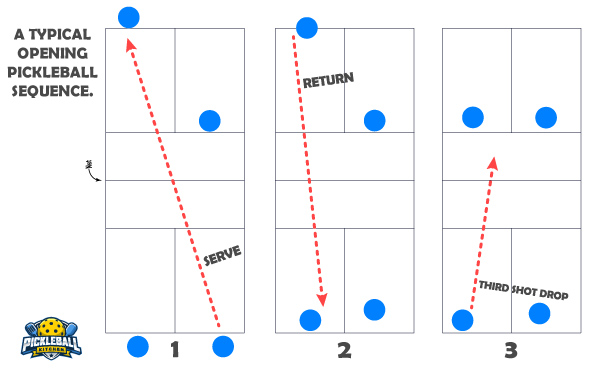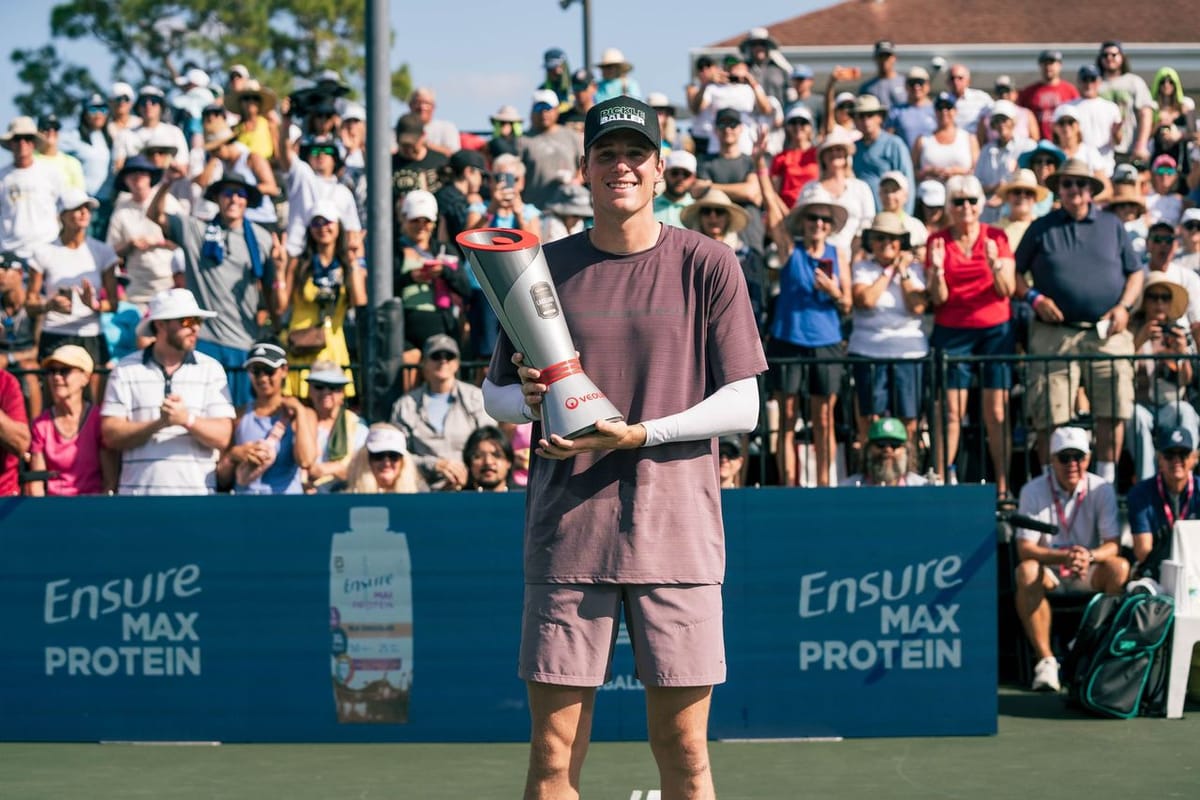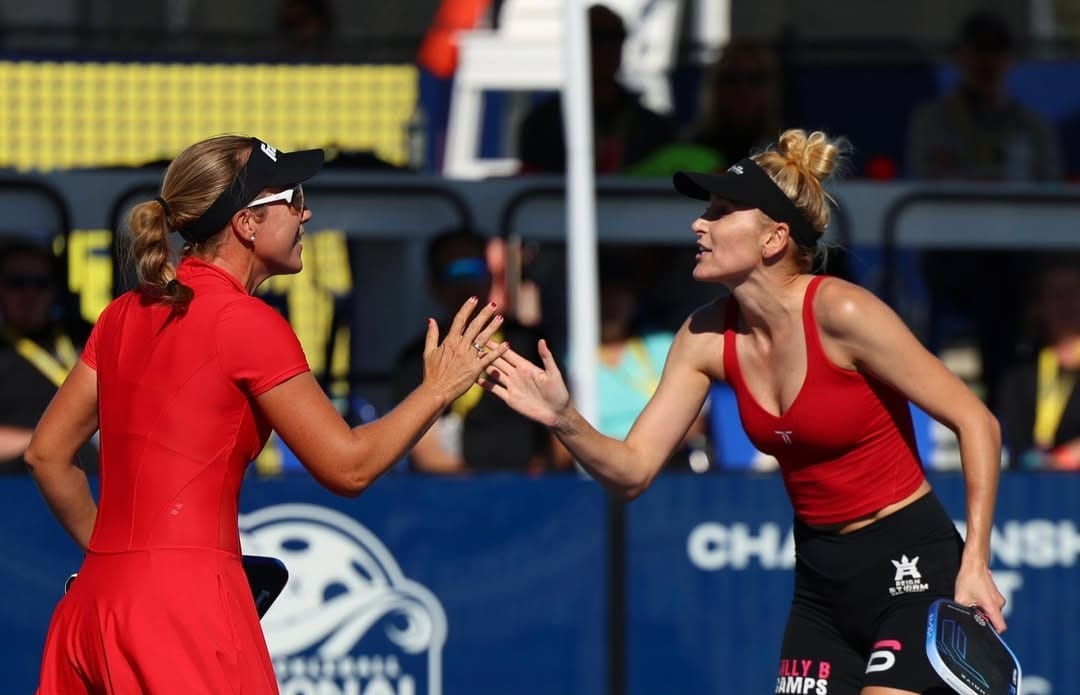The third shot drop is an essential shot to learn in pickleball. If you’ve been playing for awhile you’ve probably had more frustrating pickleball conversations about the pesky third drop shot than anything else. I’m right there with you.
If you want to become a top player in your area or if you want to start playing in tournaments, you will have to have the third shot drop a solid part of your arsenal. It doesn’t have to be perfect, but it needs to work. In this article, I’m going to explain to you what the third shot drop is, why it’s important, how to do it and how to get better at it. Let’s roll!
What is the third shot drop?
Before we begin with the instruction, I want to explain what the third shot drop is and why it’s so crucial to master. The third shot drop is a shot performed at or near the baseline that lands softly in the opponent’s kitchen. The shot is designed with mostly one thing in mind: to get your team to the net. Performing the third shot drop, however, isn’t so simple.
In general, this is what it looks like:

The green lines are the pickleball lines!
That’s me on the right. I put my camera on continuous shooting mode to show you what this looks like. Notice the green line. That’s the flight path of the ball. Luckily, the mechanics of the third shot drop are quite simple. The ball sails up into the air and drops into the kitchen.
Easy right? Yeah, not so fast. Sit tight, we’re going over technique and execution later.
Keep in mind that a “drop shot” is simply any soft shot that lands in the kitchen with the intended goal of slowing down the game. What separates the third shot drop and other drop shots is that it’s typically performed at or near the baseline.
Although the distance is only around 29 feet to the opponent’s kitchen line, it feels more like a mile. On top of that, it becomes even more difficult when you add the net, the small landing zone and the two opponents who proportionally look huge compared to the size of the court.
This is why the third shot drop is so tough. But what makes it so important?
Why is it so critical?
This is going to be complicated so please bear with me. The reason why the third shot drop is so critical to learn is that it evens out the odds of winning the rally. I’ll explain. First, look at this image:

This is what a typical opening sequence looks like in pickleball. The serve and return-serve are nothing special. They are standard, simple and quite frankly a bit boring. During these first two shots, players focus on keeping the ball in and follow the double bounce rule. But everything changes when the third shot comes around.
Before we get into it, let me ask you a question. During a pickleball rally, which team has the advantage? In general, the serving team has the advantage because they’re the ones that can score a point and potentially win the game. But if we ignore the potential to score a point, who has the advantage?
The defending team.
Big time.
Scroll up and look at the third pane in the image again. Look at the positioning. Both players on the defending team are standing at the kitchen line and are ready for anything. But if you’re the serving team, you’re all the way back and have very few options.
Remember this: in pickleball, whoever controls the net, controls the pace of the game. Whoever controls the pace of the game is the team more likely to win the rally.
The reason why the defending team has the advantage is that they are sitting comfortably at the net while the serving team is all the way back near the baseline. What should the serving team do on the third shot? Lobbing the ball over the defending team is risky because they can smash it back at you. Driving it straight at them is also risky because they can block it into the kitchen while you’re still at the baseline.
So, if you’re the serving team, how do you catch back up? What do you do? How do you get up to the net to even the odds?
You guessed it: the third shot drop.
As I explained earlier, the third shot drop is a slow, soft shot into the opponent’s kitchen. A well-executed third shot drop accomplishes two things:
- Due to how slow the ball travels with this shot, it allows you and your partner to quickly get to the kitchen before your opponent can hit their shot back over.
- It forces your opponent to dink the ball over instead of driving or smashing it over.
If you can accomplish these two things then you have successfully evened out the odds of winning the rally since you’re at the net just like the defending team.
The sheer difficulty of the third shot drop is what evens out the odds of winning the rally. It gives the defending team a fighting chance to get the ball back and prevents the serving team from constantly winning points and ending the game in mere minutes. If your third shot drop is well-polished, then you are far more likely to survive the rally and score more points (since the serving team is always the team that initiates the third shot drop). This is why the third shot drop is so important.
How to execute the third shot drop
Understanding the third shot drop is one thing, but actually doing it is a completely different adventure. I want to warn you up front: this is the most difficult shot to master in pickleball and will take you months to get good at. The reason why I’m saying this is because I’d like you to have realistic expectations when you’re working on your technique. If you’re in the middle of a match and all your drop shots are going into the net, try not to get mad at yourself. It’s difficult and it’s going to take time!
The swing
We’re going to begin by talking about how to swing at the ball for this shot. This will give you a solid foundation for the rest of the instruction.
I want to make this as easy as possible. You’re going to swing just like any other swing in pickleball. It shouldn’t be any different. Whatever kind of swing you use normally should be the same one that you use for the third shot drop. Try not to complicate things by adding spin or doing something different than what you’re used to.
You have to make sure your grip is correct too. If you’re using a strong or closed grip then it may be difficult to get the right kind of contact. Make sure your grip is neutral. For more on that, check out my article about how to hold a paddle correctly.
Aim
Aiming the third shot drop is very difficult because it’s hard to see the opponent’s kitchen from where you’re standing. The kitchen is 7 feet deep, but from our angle at the baseline, it looks more like a slice of bacon. Also, there are two people standing there which creates a psychological wall in front of you.
Look, I love bacon, but using it as a target isn’t very helpful.
Aim for the apex, not the kitchen
The third shot drop follows the same principles of physics as anything else. Whether it is a tee shot in golf, a home run in baseball or whatever else, the ball will sail up into the air, then drop. This kind of flight isn’t as pronounced in pickleball as it is other sports, but it’s there. It looks like this:

Aim for the apex, not the kitchen!
Notice how the slope on the left is steeper than on the right. As the ball is traveling through the air, it loses speed and succumbs to the force that we all know and love, gravity. This drop at the end is essential to getting the third shot drop correct. But how do we let this happen?
The key to aiming the third shot drop correctly is to actually aim at or below the apex of the flight path, not the kitchen. As long as you get the trajectory and height correct, the ball will always land in the kitchen.
The apex of the third shot drop will typically be between the landing spot in the kitchen and you. Do this:
- Visualize a spot halfway between the landing spot and you (typically your kitchen line).
- Visualize this same spot being 5-6 feet high or lower.
- Hit the ball towards that spot.
This is how you execute a third shot drop. Let it sail up into the air and gravity will do the rest. If you want, you can imagine a 6-foot person standing at your kitchen line and just aim for their head. Look at the picture above for reference. See how the apex of the flight path is near my head? For context, I’m 5’9″. So aiming a bit below that is perfect me. You’ll have to adjust your aim based on how tall you are. Also, remember that you don’t have to hit it that high. You can aim lower if you like your drop shots to be more narrow.
How it goes horribly wrong
There are many ways that a third shot drop can go wrong. If not done correctly it almost always leads to disaster. This why drilling your third shot drop with a partner is so critical. More on that later. Let’s look at some common pain points that people have with this shot.
You keep hitting it into the net
This is very common, especially for beginner pickleball players. Know this first and foremost: every advanced player has been there. And guess what? We still do it! I’m an advanced player and I still hit my third shot drops into the net sometimes. It’s going to happen. But if it’s happening consistently, then that’s when something needs to change.
Here are a few tips that you can think about when you’re working on your third shot drop.
One mistake I see all the time is people trying to run up to the kitchen and hit their third shot drop at the same time. This is a really bad idea. The reason is that while you’re moving you lose control over how hard you swing. Get set with your feet, step forward, strike the ball, then start running forward.
The next mistake that people make is purely psychological. They are afraid to hit the ball too hard. I totally get that. I used to do this too until someone said the following: it’s better to hit your third shot drop too hard, than too soft into the net. By hitting it harder, you at least give it a chance!
As we’ll talk about in a second, hitting the ball too high can allow your opponent to smash or drive the ball back at you. But sometimes they hit it too hard and it goes into the net. It’s always better to hit it too hard over the net than to hit it too short. Because at least you gave it a chance! Just focus on getting it over!
You keep hitting it too high
Besides hitting it into the net, this is the worst outcome of a third shot drop. If it’s too high, the opponent will either be able to smash it out of the air, or it will bounce high enough to where they can drive it back at you. Either scenario is bad.
If you’re aiming for the kitchen then this could be the reason why. It’s just too difficult aiming for the kitchen and it can force people to hit it too hard. Try what I recommend above which is to hit the ball towards the apex of the preferred flight instead of aiming for the kitchen. You have to practice though. It’s not going to gel with you just by reading this.
The final thing I would recommend is to not be afraid of hitting it into the net. I know it’s intimidating, but try to force yourself to hit softer shots. Do this continually and you’ll eventually get used to it. And of course, keep practicing!
When to NOT use the third shot drop
The third shot drop is often treated as sacred. It’s such an important shot in pickleball that players confuse it for being important to use in all situations. But this is not true!
The third shot drop is something you use if both of your opponents are already at the kitchen line. As I mentioned earlier in the article, using the third shot drop in this situation is your only option. But what if the return serve was a bit short? Or what if your opponent hit it up too high? I have three words for you.
Smack that thing!
Smack it real good! If you have the opportunity to drive the ball back over, then do it! This is especially effective if the opponent hits it up high and short. Drive it back over instead of using a drop shot.
Also, what if you have an opponent that hasn’t run up to the kitchen yet? Should you use a third shot drop? No, definitely not, Remember, whoever controls the net, controls the game. Using a third shot drop, in that case, would only encourage your opponents to run up to the net. That’s not what you want. Instead, hit it to their feet in order to keep them away from the kitchen.
One great drill for practicing the third shot drop
Drilling the third shot drop is really easy especially if you have a partner to work with. If you don’t, just be ready to pick up a ton of pickleballs.
Stand at the baseline and have your partner stand at the opposite kitchen line. Have your partner hit a shot to you, then hit your third shot drop. Each time you hit it, have your partner tell you where it landed and if it was too high or not. Keep doing this over and over!
This is also a perfect drill for your warm up. As I mentioned in another article about how to get better at pickleball, warming up with the third shot drop is critical. This is especially the case if you’re playing on a court that you’ve never played on.
How you visualize and see the shot in front of you is a big part of third shot drops. If you go play at a different pickleball location, then everything is going to look different to you. This could include the lines on the court, the floor, even the net. All of these things will look foreign to you while you’re executing a third drop shot. So before you start playing, warm up with your drop shots first in order to get used to the new experience.
Wrapping up
I can’t stress enough how important the third shot drop is. If you’re looking to play at a high level or at least be recognized as a great player in your area, your third shot drop has to be immaculate. But remember, it’s not used for every situation! I hope the article was helpful to you. If you have any comments or questions leave them below!
Anuncie Aqui / Advertise Here
Sua marca para o mundo Pickleball! / Your brand for the Pickleball world!

 English
English  Spanish
Spanish  Portuguese
Portuguese  German
German  Italian
Italian  Japanese
Japanese  French
French  Polish
Polish  Russian
Russian  Netherlands
Netherlands  Hungarian
Hungarian  Turkish
Turkish  Videos
Videos  Pickleball Kitchen
Pickleball Kitchen








 English (US) ·
English (US) ·  Portuguese (BR) ·
Portuguese (BR) ·